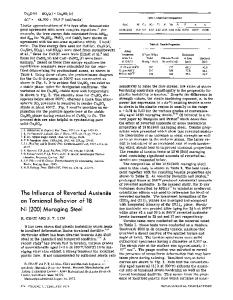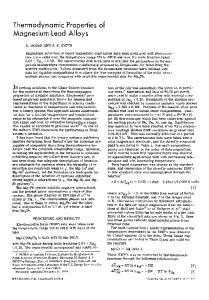Thermodynamic Properties of AuSb 2
- PDF / 410,593 Bytes
- 5 Pages / 612 x 792 pts (letter) Page_size
- 30 Downloads / 380 Views
modynamic Properties of AuSb2 A. V. Tyurina, *, D. A. Chareevb, and N. A. Polotnyankoc a
Kurnakov Institute of General and Inorganic Chemistry, Russian Academy of Sciences, Moscow, 119991 Russia b Korzhinskii Institute of Experimental Mineralogy, Russian Academy of Sciences, Chernogolovka, Noginskii raion, Moscow oblast, 142432 Russia cDubna State University, Dubna, Moscow oblast, 141982 Russia *e-mail: [email protected] Received May 20, 2020; revised July 10, 2020; accepted July 17, 2020
Abstract—We have for the first time determined the temperature dependence of heat capacity for aurostibite, AuSb2, by adiabatic calorimetry and calculated its standard thermodynamic functions in a wide temperature range. At a temperature of 298.15 K, we have obtained C °p = 76.01 ± 0.15 J/(mol K), S° = 133.4 ± 0.3 J/(mol K), Н°(298.15 K) − Н°(0)= 17.39 ± 0.03 kJ/mol, and Ф° = 75.02 ± 0.15 J/(mol K). Using previously reported data and the present results, we have found ΔfG°(298.15) = −11.36 ± 0.90 kJ/mol. Keywords: gold antimonide, aurostibite, heat capacity, adiabatic calorimetry, thermodynamic functions DOI: 10.1134/S002016852012016X
INTRODUCTION Gold forms various intermetallic compounds, some of which are encountered in nature in the form of intrinsic minerals, for example, aurostibite, AuSb2 [1]. No other chemical compounds of gold with antimony are known at the present stage. AuSb2 is formed by a peritectic reaction at 460°C and reacts eutectically with gold at 380°C [2]. Previously, interest in intermetallic antimony compounds was aroused mainly by the presence of this element as an impurity in ores of noble metals, for example, silver and gold. However, after the discovery of semiconducting properties, electronic and optical data found many potential applications for intermetallic compounds, which makes thermodynamic characterization of the Sb–Au system more important. Using experiments on in situ deposition in a highvacuum electron microscope, Mori and Yasuda [3] studied the doping behavior of antimony atoms in nanometer gold clusters and that of gold atoms in antimony clusters a few nanometers in size. As a result, they obtained clusters of the intermetallic compound AuSb2. This indicates that AuSb2, whose melting point is 733 K, can readily be formed via simple deposition of atomic antimony vapor on gold clusters or atomic gold vapor on antimony clusters at the ambient temperature. One of the purposes of this work was to assess the thermodynamic plausibility of the forma-
tion of bulk AuSb2 crystals from their constituent elements. In addition, the purpose of this work was to determine standard thermodynamic functions of AuSb2, a synthetic analog of the mineral aurostibite. Moreover, obtaining new thermodynamic data for this phase will allow in the future for physicochemical modeling of conditions for the formation of gold-containing deposits. The thermodynamic functions of AuSb2 are important for modeling phase equilibria in systems of practical importance, including Au−In−Sb [4], Au−Pb−Sb [5], Au−Sb−Sn [6], and othe
Data Loading...











